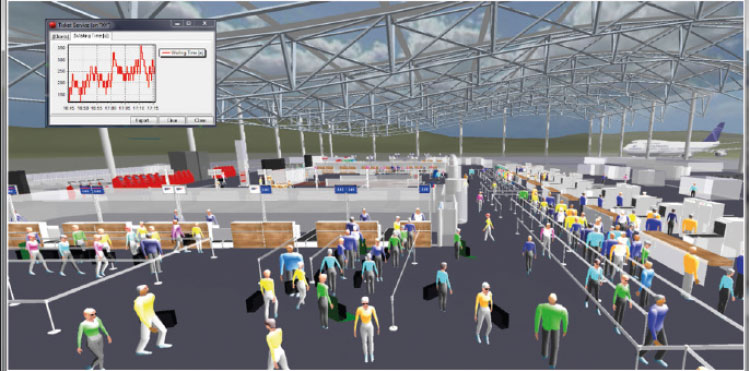
The world-leading CAST 3D airport simulation software, developed and distributed by ARC, comprises simulation, planning and optimisation systems for pedestrian, vehicle and aircraft traffic to model processes of landside, terminal, airside and airspace.
Airport Research Center GmbH is an independent global provider of professional airport planning and decision support services, which are designed to optimise investments and reduce operational costs. Michael Laubrock, Managing Partner at Airport Research Center, outlined the myriad capabilities of its CAST 3D airport simulation software to Ross Falconer.
Fast time simulation has become an essential and proven tool for optimising operations across all airport processes. It allows for efficient communication and quick decision-making.
Airport Research Center GmbH (ARC) takes what is clearly an innovative and future-proof approach to simulation software. It offers a comprehensive range of products and services that include airport planning and design, capacity assessment and simulation, aviation market analysis and demand forecasting, and expert consulting in strategy development. Based on user-driven requirements, the goal is to provide a state-of-the-art simulation, offering the highest level of detail and accuracy.
ARC has worked with several airports and customers worldwide, performing tasks such as determining the capacity of several components of the airport, concepts for short and long-term development, advice on project phasing, stand and apron capacity, test and validation of new infrastructure, provision of the CAST simulation platform, support of the masterplanning process, and terminal
safety studies
CAST 3D airport simulation software, developed and distributed by ARC, comprises simulation, planning and optimisation systems for pedestrian, vehicle and aircraft traffic to model processes of landside, terminal, airside and airspace. Airport efficiency means smooth operations, and the optimal utilisation of infrastructure and human resources.
Michael Laubrock, Managing Partner at Airport Research Center, explained that a permanently available simulation model represents an airport with all its relevant operational components, providing a test environment always available for various questions to be asked. This may concern the short or medium-term future, or both, pointing to the overall performance or any logical or physical part, such as occupancy of a specific terminal area. “In order to provide a suitable tool for this task, Airport Research Center has equipped the simulation software CAST with appropriate interfaces and analysis functions,” Laubrock said. “This allows a very time-efficient generation and distribution of information, and a baseline for quick decisions. Dependent on specific stakeholder’s needs, the relevant system parts of air and landside are considered.”
By using a CAST simulation, the factors influencing an airport’s key performance indicators can be determined, and the effects of different decisions can be quantified. Seeing the operations in 3D helps to understand the causes and effects. “This leads not only to better decisions, but also to transparency and a common acceptance of management actions,” Laubrock added.
SESAR APOC simulation task
Significantly, it was recently announced that the CAST Airport Simulation software, developed and provided by ARC in cooperation with Airbus Defence and Space, has been extended to build the simulation core of an airport gaming simulation platform, which has been selected for the SESAR APOC (Airport Operational Control Center) simulation task by EUROCONTROL.
“For SESAR, CAST, together with external stakeholder interfaces developed by Airbus, provides the simulation and gaming test bed for the SESAR concepts, like Total Airport Management, where the processes of performance steering, performance monitoring, performance management, and post operations management, build the core for proactive decision-making,” Laubrock explained. “The concepts are tested in a dynamic simulation environment, where CAST provides a full model of the airport, not only representing the infrastructure and traffic, but also all related processes, control actions and the information flow between the contributing parties.”
Within this environment, individual stakeholders, such as airlines, ATC, airports, or ground handlers, in front of their individual screens, are presented with information and can update the system according to their operational priorities. In doing so, they can refine those elements of the operational concept, focusing on overall airport performance management and the collaborative decision-making process.
The fact that the system is highly realistic, visual and dynamic means that participants are easily able to ‘imagine’ that they are working in their own operational environment and, therefore, provide highly valuable feedback.
These activities show that CAST can provide packages tailored to the requirements of a wide range of clients. These can range from small and simple tasks, such as simulation support for operational planning of dedicated areas, to an integrated view of the whole airport to support major, wide-ranging decisions. The user can start quickly and simply, but is not limited if the tasks are
more complex.







